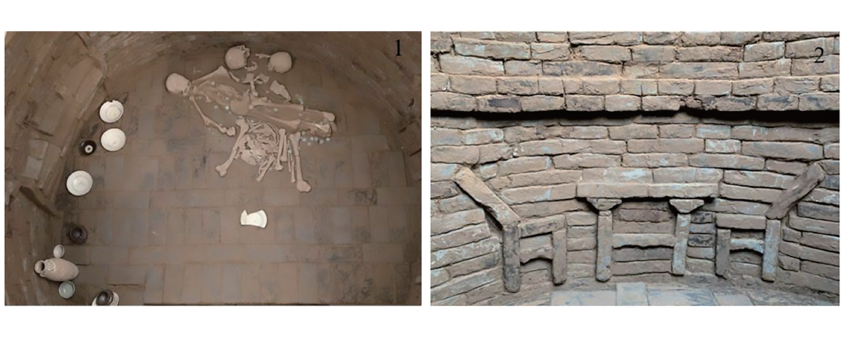

Survival stress of the Yuan Dynasty population in Guangrao, Shandong
Received date: 2023-10-10
Accepted date: 2024-01-11
Online published: 2025-04-15
This paper presents an archaeological study of human bone remains and stable isotope analysis of 19 Yuan Dynasty human bone specimens excavated from the Shicun North Cemetery in Guangrao, Shandong in 2021. Based on burial items and tomb layout, it is concluded that the Shicun North Cemetery dates back to the Yuan Dynasty. With a minimal quantity of mostly common burial objects per tomb, this cemetery is identified as a civilian cemetery. The research aims to gain insights into the survival stress of the people in Guangrao, Shandong during the Yuan Dynasty.
Three individuals had fractures, including lumbar vertebra compression fractures, metatarsal fractures, and frontal bone fractures. The frontal bone’s depressed fracture, potentially caused by violence, was relatively rare. This indicates that society was likely stable at that time. There might have been occasional minor disputes, but overall, people lived in peace.
The results of C and N isotope analysis show that the cemetery population mainly consumed millet and wheat, which is consistent with the grain-consumption structure of the Yuan Dynasty in Shandong, where both millet and wheat were equally emphasized. Meanwhile, the meat supply for the population was relatively abundant and nutritious, yet there were differences in individual consumption levels.
In the study of survival stress, most people in this cemetery community survived the vulnerable growth and development stages, with only a small number failing to do so due to nutritional status or other factors. To conduct the analysis, the population was divided into adults and minors using osteological paradox and life-history studies. The four minor cases had varying stress-bearing capacities, but none developed strong resistance and adaptability after experiencing severe growth-related stress. One individual was in a vulnerable state and had the strongest pressure-bearing ability among them. Another individual had a weaker pressure-bearing ability compared to others.
Adult individuals, benefiting from sufficient nutrition, entered a healthy period after reaching adulthood, with high levels of physical and physiological health, strong resilience, and the ability to tolerate and adapt to stress to a certain extent. However, adults also faced higher stress levels because, due to social status and other reasons, they lacked adequate cultural buffering mechanisms.

Key words: cemetery; Yuan Dynasty; human skeleton; paleopathology
GUO Mingxiao , ZHAN Senyang , ZENG Wen , YOU Haijie , SONG Meiling . Survival stress of the Yuan Dynasty population in Guangrao, Shandong[J]. Acta Anthropologica Sinica, 2025 , 44(02) : 270 -282 . DOI: 10.16359/j.1000-3193/AAS.2024.0102
| [1] | 何嘉宁. 中国古代人骨体质人类学的研究进展与展望[J]. 人类学学报, 2021, 40(2): 165-180 |
| [2] | Goodman AH, Martin DL, Armelagos GJ. Indications of stress from bone and teeth[A]. In: Cohen MN, Armelagos GJ(Eds). Paleopathology at the origins of Agriculture[C]. Orlando: Acdemic press, 1984, 13-44 |
| [3] | Wood JW, Wilkinson RG. The Osteological Paradox: Problems of Inferring Prehistoric Health from Skeletal Samples[J]. Current Anthropology, 1992, 33(4): 343-358 |
| [4] | Marklein KE, Leahy RE, Crews DE. In sickness and in death: assessing frailty in human skeletal remains[J]. American Journal of Physical Anthropology, 2016, 161(2): 208-225 |
| [5] | Robb J. Time and Biography[A]. In: Hamilakis Y, Pluciennik M, Tarlow S(Eds). Thinking through the Body: Archaeologies of Corporeality[C]. Boston: Springer, 2002, 153-171 |
| [6] | 贺乐天. 新疆吐鲁番加依墓地古代居民生存压力研究[D]. 硕士学位毕业论文, 长春: 吉林大学, 2015, 1-4 |
| [7] | 郑丽慧. 内蒙古四王子旗城卜子元代墓葬出土人骨的人种学研究[D]. 硕士学位毕业论文,吉林大学, 2003 |
| [8] | 方启, 魏东, 魏坚. 元上都周围墓葬出土元代人骨研究[A]. 见:魏坚.元上都(上)[M]. 北京: 中国大百科全书出版社, 2008, 147-214 |
| [9] | 张馨月, 赵永生. 广饶县十村遗址出土人骨鉴定报告[J]. 海岱考古, 2016, 145-153 |
| [10] | 张馨月. 山东地区古代居民牙齿情况的初步分析[D]. 硕士学位毕业论文,山东大学, 2016 |
| [11] | 胡春佰. 集宁路古城金元时期墓葬出土人骨研究[D]. 硕士学位毕业论文,吉林大学, 2020 |
| [12] | 朱泓. 体质人类学[M]. 北京: 高等教育出版社, 2004, 92-106 |
| [13] | 邵象清. 人体测量手册[M]. 上海: 上海辞书出版社, 1985, 34-393 |
| [14] | White TD, Folkens PA. The human bone manual[M]. Diego: Academic Press, 2005, 379-409 |
| [15] | Buikstra JE, Ubelaker DH. Standards for data collection from human skeletal remains[M]. Fayetteville: Arkansas Archeological Survey, 1994, 15-58 |
| [16] | Ambrose SH. Preparation and characterization of bone and tooth collagen for isotopic analysis[J]. Journal of Archaeological Science, 1990, 17(4): 431-451 |
| [17] | Steckel RH, Larsen CS, Sciulli PW, et al. Data collection codebook[A]. In: Steckel RH, Larsen CS, Roberts CA(Eds). The Backbone of Europe: Health, Diet, Work and Violence over Two Millennia[C]. Cambridge: Cambridge University Press, 2018, 397-427 |
| [18] | 张君. 从筛状眶和多孔骨肥厚考察中国古代人骨上的贫血现象[J]. 考古, 2009, 10: 86-90 |
| [19] | [英]夏洛特·罗伯茨, 等(著). 疾病考古学[M]. 译者:张桦. 济南: 山东画报出版社, 2010, 188-189 |
| [20] | [英]夏洛特·罗伯茨, 等(著). 疾病考古学[M]. 译者:张桦. 济南: 山东画报出版社, 2010, 93-144 |
| [21] | [明]孟楠(修), 蒋奇鎛(纂). 乐安县志[M]. 北京: 中华书局, 标点本,卷七, 2014 |
| [22] | 周立刚, 孙凯, 孙蕾. 明代周懿王墓地出土人骨稳定碳氮同位素分析[J]. 华夏考古, 2019, 2: 48-52 |
| [23] | Stuart-Macadam P. Porotic hyperostosis: representative of a childhood condition[J]. American Journal of Physical Anthropology, 1985, 66: 391-398 |
| [24] | Walker PL. Anemia among prehistoric Indians of the American Southwest[J]. Health and disease in the prehistoric Southwest, 1985, 34: 139-162 |
| [25] | Hillson S. Tooth Development in Human Evolution and Bioarchaeology[M]. Cambridge: Cambridge University Press, 2014, 198-227 |
| [26] | Facchini F, Rastelli E, Brasili P. Cribra orbitalia and cribra cranii in roman skeletal remains from the Ravenna area and Rimini(I-IV century AD)[J]. International Journal of Osteoarchaeology, 2004, 14(2): 126-136 |
| [27] | Arking R. The Biology of Aging: Observations and Principles[M]. New York: Oxford University Press, 2006, 501 |
/
| 〈 |
|
〉 |